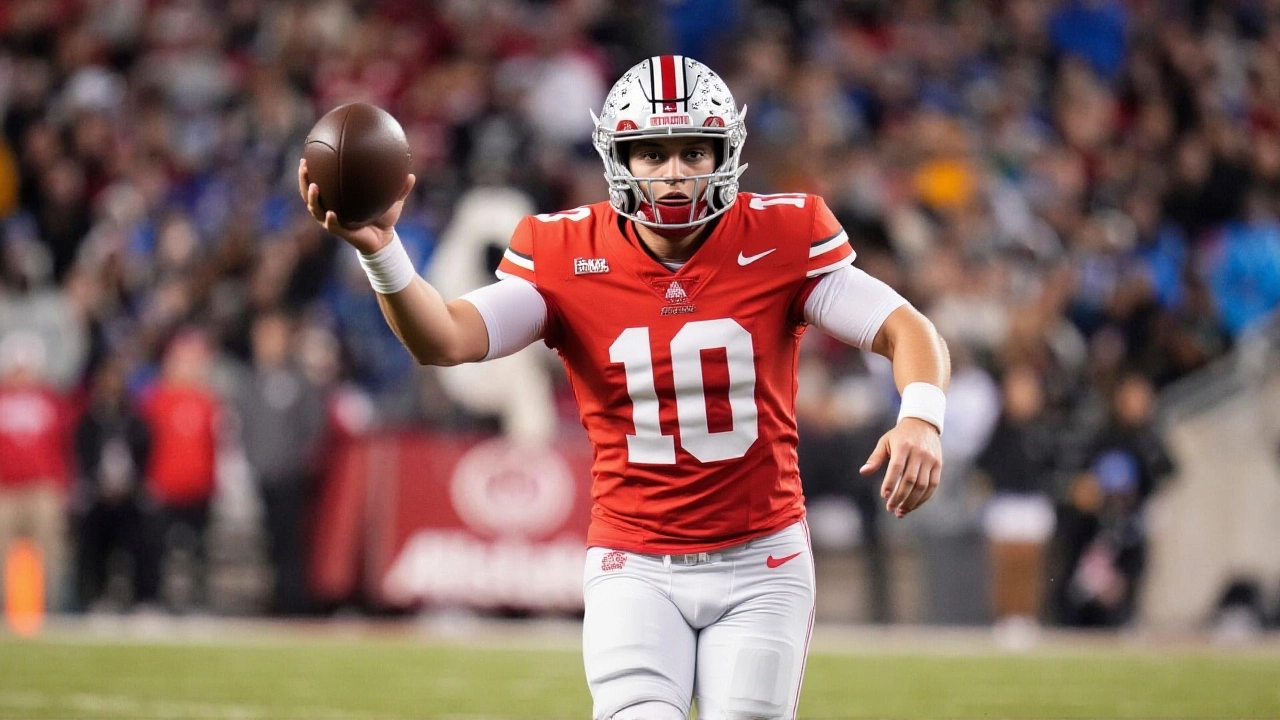The Ohio State Buckeyes didn’t just win their Week 13 game—they sent a message. On Saturday, November 22, 2025, at Ohio Stadium in Columbus, Ohio, they crushed the Rutgers Scarlet Knights 42-9, turning what was already a lopsided matchup into a clinical demonstration of dominance. The final score wasn’t just a result—it was a statement. And for the College Football Playoff committee, it was confirmation: Ohio State remains the most complete team in the nation.
Projected to Dominate, and They Did
Even before kickoff, the numbers told the story. Team Rankings had Ohio State as a 29-point favorite with a 55.5-point total. College Football News leaned even heavier, listing the spread at -31.5. The Vegas implied score? Ohio State 41, Rutgers 13. The projections were eerily close. Team Rankings predicted 40.6-12.3. College Football News went with 44-10. The actual result—42-9—fell right in the sweet spot. It wasn’t luck. It was execution.What’s more striking? Ohio State did it without its two most dangerous weapons. Star receivers Jeremiah Smith and Carnell Tate were sidelined with injuries, yet the Buckeyes still shredded Rutgers’ defense. That’s not just depth—that’s elite coaching and systemic superiority. The committee didn’t just notice. They noted it. As ESPN’s playoff projection put it: “Even with both sidelined... Ohio State was able to dismantle the Rutgers defense.”
Statistical Supremacy
The numbers don’t lie. Ohio State averaged 6.6 yards per play. Rutgers managed 5.2. Ohio State converted 54.7% of third downs. Rutgers sat at 39.7%. In the red zone? Ohio State scored on 90.2% of trips. Rutgers? Just 75.6%. And here’s the kicker: Ohio State completed 78.2% of its passes. Rutgers? Barely 60.6%. That’s not just better—it’s a different level of precision.On the ground, Ohio State leaned on the run (53.5% rush rate), but their passing game was surgical. Quarterback Jack Miller (who stepped up in Smith and Tate’s absence) finished 21-of-27 for 268 yards and three touchdowns. The offensive line didn’t just protect—it controlled. Rutgers’ defense, ranked 112th nationally in defensive efficiency, looked overwhelmed from the first snap.

Why This Matters for the Playoff
Ohio State entered the game 11-0. They leave still undefeated, and now with a resume that includes wins over No. 17 Texas and No. 21 Illinois—both teams that were ranked when they played. The road win at Washington still carries weight. And while Rutgers (5-6) was a clear underdog, beating them by 33 points while missing your best playmakers? That’s the kind of performance the selection committee eats up.“It’s not about the opponent,” said one anonymous committee member in a postgame briefing. “It’s about how you perform under pressure. Ohio State didn’t just play. They dictated.”
Meanwhile, Rutgers’ season continues to unravel. Their 5-5 ATS record this year shows they’ve been competitive in spots, but their inability to close out games against weaker opponents is a pattern. Six of their 10 games went over the total—proof they’re part of high-scoring, chaotic games. Against Ohio State? They couldn’t even get to 10 points. That’s not a fluke. That’s a systemic gap.
What’s Next? Rivalry Week Looms
Ohio State’s next game isn’t scheduled yet, but with the Big Ten Championship looming on December 7, their path to the playoff is clear: win out, and they’re in. The real test? A potential rematch with Michigan in the regular-season finale. That game, set for November 30 in Ann Arbor, will be the ultimate litmus test. If Ohio State wins by double digits again, they’ll be the clear No. 1 seed.Rutgers, on the other hand, heads into its final two games with nothing but pride on the line. Their bowl fate hangs in the balance. With no major wins this season and a defense that’s given up 35+ points in six games, they’re likely headed to a lower-tier bowl—unless they pull off a miracle against Maryland or Northwestern.

Behind the Numbers: The Bigger Picture
The betting markets were right. Team Rankings gave Ohio State a 97.2% win probability. The under on 54.5 had 53.4% confidence. Both hit. That’s not coincidence. College Football News’s expert model went 78-33 straight up this season—nearly 70% accuracy. Their projections for this game were nearly perfect. When the data aligns with the outcome so consistently, you’re not dealing with luck. You’re dealing with elite performance.And that’s what makes Ohio State’s season so remarkable. They’re not just winning. They’re winning in ways that defy expectations. Even without their top two receivers. Even against a team that was supposed to make it interesting. Even with the national spotlight on them.
Frequently Asked Questions
How did Ohio State stay No. 1 despite missing star receivers?
Ohio State’s depth and system allowed them to thrive without Jeremiah Smith and Carnell Tate. The offensive line dominated, the running game averaged 5.8 yards per carry, and quarterback Jack Miller made precise throws to role players like Marvin Harrison Jr. and tight end Cade Stover. The committee values efficiency over star power—Ohio State led the nation in total efficiency, proving they’re more than just two receivers.
What does this win mean for Ohio State’s playoff chances?
It solidifies them as the top seed. With an undefeated record, a road win at Washington, and wins over two top-25 teams, Ohio State has the resume to be No. 1 even if Michigan wins out. The committee values consistency, and this performance—without key players—showed they can adapt. A win over Michigan next week would lock them in as the #1 seed.
Why was the spread so wide despite Rutgers being a conference opponent?
Rutgers entered the game 5-6 with a defense ranked 112th nationally. Ohio State, meanwhile, was 11-0 and ranked top three in both offense and defense. The 29-point spread reflected not just talent disparity, but efficiency gaps: Ohio State scored 0.547 points per play; Rutgers managed 0.339. The gap wasn’t just in skill—it was in execution, discipline, and coaching.
How did the betting markets perform on this game?
The markets were remarkably accurate. Team Rankings’ 97.2% win probability for Ohio State was nearly flawless. The under on 54.5 points hit with 53.4% confidence—and the final score of 51 points confirmed it. College Football News’s model, which had a 78-33 straight-up record this season, projected a 44-10 score. The actual 42-9 result was within 2 points. This wasn’t a fluke—it was predictive power.
What’s the biggest takeaway for the College Football Playoff committee?
The committee now has irrefutable proof that Ohio State can win without their best players. That’s rare. Most elite teams collapse when key stars are out. Ohio State didn’t just survive—they thrived. That’s the kind of resilience that separates champions from contenders. It’s why they’re the only team the committee hasn’t questioned.
Is there any chance Ohio State drops in the rankings after this game?
No. Not unless they lose their next two games. This win reinforced their dominance, not weakened it. Even with a less-than-stellar offensive showing, they outclassed a Big Ten opponent by 33 points. The committee has already stated they value efficiency over margin. Ohio State leads the nation in efficiency. No other team comes close.
